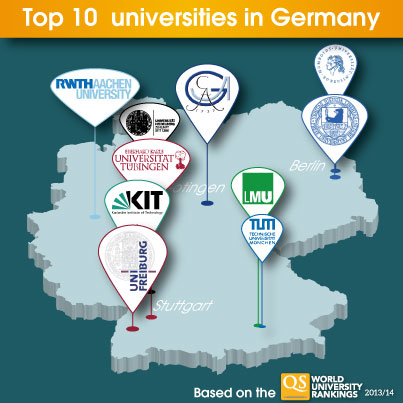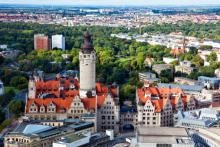If you'd like to take a look at the latest version of this article, based on the QS World University Rankings 2015/16, visit this page. For the 2013/14 results, read on.
The 2013/2014 QS World University Rankings® features 42 top universities in Germany. These are mainly concentrated in the more populous states of North Rhine-Westphalia, Baden-Württemberg, Bavaria and Hesse, which host 27 of these leading German universities between them.
While there is a concentration of top German universities in the more populous parts of the country, they generally don’t cluster in any one city. There are only two German cities with more than one top ranking university: Munich has two, and capital city Berlin has three.
The top performing German institution this year is the Ruprecht-Karls-Universität Heidelberg (ranked 50th in the world) in North Rhine-Westphalia. Like other top universities in Germany, it has been consistently close to the top of the rankings for the last five years. This follows the establishment of the national Excellence Initiative in 2005, a joint commission of the German Research Foundation (DFG) and the German Council of Science and Humanities.
The development of top universities in Germany

From 2007 to 2012, the Excellence Initiative Grants Committee provided €1.9 billion (US$2.56 billion) to 85 institutions, to strengthen research and enhance Germany’s visibility in the scientific community. A significant amount of that funding (up to €13.5 million or US$18.24 million each per year) went to nine institutions for proposed future concepts, and eight of those appear within the top 150 in the world this year.
A further €2.4 billion (US$3.25 billion) was approved last year for the second phase of the program. This will benefit a total of 99 institutions, including eleven universities selected for their future concepts. Six from the previous round have retained their funding, and five more have been added. All the institutions which receive funding enjoy enhanced status as an elite institution.
In addition, an alliance of nine technological universities called TU9 (Technische Universität 9) are known for excellence in research. These all have a high number of international students, with an average of 15% of students from outside Germany.
Here’s a quick overview of the top universities in Germany by state (known as Länder), based on the QS World University Rankings® 2013/14.
Top universities in North Rhine-Westphalia
The western  state of North Rhine-Westphalia is the most populous in Germany, with its 17.5 million residents accounting for almost 22% of the country’s 80.5 million. It is a leading player in the German economy and includes the most important industrial area – the Rhine-Ruhr region, which is one of the largest metropolitan areas in Europe.
state of North Rhine-Westphalia is the most populous in Germany, with its 17.5 million residents accounting for almost 22% of the country’s 80.5 million. It is a leading player in the German economy and includes the most important industrial area – the Rhine-Ruhr region, which is one of the largest metropolitan areas in Europe.
It also has the highest number of ranking institutions (nine), led by the Rheinisch-Westfälische Technische Hochschule Aachen, ranked 147 in the world. Among the top universities in North Rhine-Westphalia, this institution is the only TU9 member, and it is also one of two in the state to receive funding from the Excellence Initiative for its institutional strategy. The other is Universität Köln.
The top universities in North Rhine-Westphalia are:
- Rheinisch-Westfälische Technische Hochschule Aachen (ranked 147 in the world; 10th in Germany)
- Rheinische Friedrich-Wilhelms-Universität Bonn (ranked 163= in the world; 11th in Germany)
- Westfälische Wilhelms-Universität (ranked 236= in the world; 15th in Germany)
- Universität Köln (ranked 243 in the world; 16th in Germany)
- Ruhr-Universität Bochum (ranked 366= in the world; 29th in Germany)
- Universität Düsseldorf (ranked 394= in the world; 31st in Germany)
- Universität Bielefeld (ranked 431-440 in the world; 35th in Germany)
- Universität Duisburg-Essen (ranked 481-490 in the world; 38th in Germany)
- Technische Universität Dortmund (ranked 501-550 in the world; 39th in Germany)
Top universities in Baden-Württemberg
Baden-Württemberg is the third largest state by both size and population (almost 11 million). Known as the “car state”, it is famous for its automobile industry (including Daimler, Porsche and Audi), and also mechanical engineering and metal-working.
The region’s industrial characteristics exist alongside mythical elements, such as the Black Forest – the setting for many of the brothers Grimm fairy tales. And there are several enchanting historic towns, including the university town of Tübingen, where students make up a quarter of the population.
The state capital, Stuttgart, is the home of Mercedes Benz, but is also known as one of the greenest cities in Europe. It is home to Universität Stuttgart, a member of TU9. The region’s other TU9 member is KIT, Karlsruher Institut für Technologie. And the top-ranking German university in the world, the Ruprecht-Karls-Universität Heidelberg, can be found in the entirely baroque-styled town of Heidelberg.
The top universities in Baden-Württemberg are:
- Ruprecht-Karls-Universität Heidelberg (ranked 50 in the world; 1st in Germany)
- Universität Freiburg (ranked 102= in the world; 4th in Germany)
- KIT, Karlsruher Institut für Technologie (ranked 116= in the world; 6th in Germany)
- Eberhard Karls Universität Tübingen (ranked 134= in the world; 9th in Germany)
- Universität Stuttgart (ranked 248 in the world; 17th in Germany)
- Universität Ulm (ranked 258 in the world; 18th in Germany)
- Universität Konstanz (ranked 273 in the world; 21st in Germany)
- Universität Mannheim (ranked 281= in the world; 23rd in Germany)
Top universities in Bavaria
Bavaria is the  biggest state by size in Germany, and the second most populous at around 12.5 million. It is also one of the oldest states in Europe, and has the highest number of beer breweries in Germany.
biggest state by size in Germany, and the second most populous at around 12.5 million. It is also one of the oldest states in Europe, and has the highest number of beer breweries in Germany.
Like Baden-Württemberg, Bavaria does a good job of combining diverse elements – “laptops and lederhosen”, as one official site sums it up. Heavily industrialized areas where automobile, electrical and engineering firms engage in business can be found in the Nuremberg-Erlangen-Fürth region, and also in Munich, Bavaria’s capital and gateway to the Bavarian Alps.
The first- and second-highest ranking top universities in Bavaria are both found in Munich: the Technische Universität München (TU München) and the Ludwig-Maximilians-Universität München. TU München is a TU9 member, and both institutions receive funding under the Excellence Initiative.
The top universities in Bavaria are:
- Technische Universität München (ranked 53 in the world; 2nd in Germany)
- Ludwig-Maximilians-Universität München (ranked 65 in the world; 3rd in Germany)
- Universität Erlangen-Nürnberg (ranked 278 in the world; 22nd in Germany)
- Julius-Maximilians-Universität Würzburg (ranked 325= in the world; 27th in Germany)
- Universität Regensburg (ranked 401-410 in the world; 32nd in Germany)
- Universität Bayreuth (ranked 411-420 in the world; 33rd in Germany)
Top universities in Hesse
As the seventh largest state out of 16 in Germany, Hesse’s population of almost 6 million makes it one of the most densely populated states. Hesse has two capitals: the banking metropolis of Frankfurt, which is Germany’s financial capital, and the state capital of Wiesbaden, one of the oldest spa towns in Europe.
largest state out of 16 in Germany, Hesse’s population of almost 6 million makes it one of the most densely populated states. Hesse has two capitals: the banking metropolis of Frankfurt, which is Germany’s financial capital, and the state capital of Wiesbaden, one of the oldest spa towns in Europe.
Hesse is known for its healthy economy, and has a higher than average percentage of students studying economic disciplines. Frankfurt in particular, with its Bundesbank and European Central Bank headquarters, is sometimes known as “Bankfurt”. It has little to offer history enthusiasts, after being completely destroyed in WWII, but it hosts the top ranking university in the state: Universität Frankfurt am Main, which ranks 208 overall, and 150th in the world for social sciences and management.
The Technische Universität Darmstadt (TU Darmstadt) gave Darmstadt its name of “the city of science”, and is another TU9 member.
The top universities in Hesse are:
- Universität Frankfurt am Main (ranked 208 in the world; 14th in Germany)
- Technische Universität Darmstadt (ranked 260 in the world; 19th in Germany)
- Philipps-Universität Marburg (ranked 431-440 in the world; 36th in Germany)
- Justus-Liebig-Universität Gießen (ranked 501-550 in the world; 40th in Germany)
Top universities in Berlin
Germany’s capital  city/state, Berlin, is the seat of the national parliament and government. More than a third of Berlin’s 3.4 million residents were not born in the city, which hosts people from over 190 countries. This makes it more multicultural and cosmopolitan than most German states, and it’s also well known for its focus on creativity and creative disciplines.
city/state, Berlin, is the seat of the national parliament and government. More than a third of Berlin’s 3.4 million residents were not born in the city, which hosts people from over 190 countries. This makes it more multicultural and cosmopolitan than most German states, and it’s also well known for its focus on creativity and creative disciplines.
Visitor attractions include the remnants of the Berlin Wall, the history- and culture-packed Museum Island, famous theaters, legendary nightlife, and, of course, some of the top universities in Germany, including another TU9 member: Technische Universität Berlin.
The top universities in Berlin are:
- Freie Universität Berlin (ranked 109 in the world; 5th in Germany)
- Humboldt-Universität zu Berlin (ranked 126 in the world; 7th in Germany)
- Technische Universität Berlin (ranked 183= in the world; 12th in Germany)
Top universities in Lower Saxony
Germany’s second  largest state, Lower Saxony (population around 8 million) provides a key link between the east and west of the European continent, following the reunification of Germany in 1989. In keeping with the mobility theme, Lower Saxony is another state known for its automobile industry, and is also a major energy producer.
largest state, Lower Saxony (population around 8 million) provides a key link between the east and west of the European continent, following the reunification of Germany in 1989. In keeping with the mobility theme, Lower Saxony is another state known for its automobile industry, and is also a major energy producer.
But it has its fair share of mythical elements too, especially the city of Hamelin, associated with the Pied Piper story. And the city of Göttingen leaves industrialization well behind in the historic city center, with houses dating from the 14th century. The state’s top ranking university, Georg-August-Universität Göttingen, is the focal point of a city that is known as a sort of German Cambridge or Oxford.
Lower Saxony also hosts two TU9 members: Technische Universität Braunschweig (TU Braunschweig) and Leibniz Universität Hannover.
The top universities in Lower Saxony are:
- Georg-August-Universität Göttingen (ranked 128 in the world; 8th in Germany)
- Leibniz Universität Hannover (ranked 451-460 in the world; 37th in Germany)
- Technische Universität Braunschweig (ranked 501-550 in the world; 41st in Germany)
Top universities in Saxony
The Free State  of Saxony (population around 4 million) is only the tenth largest of the 16 states, but is home to Europe’s largest micro-electronics industry association, called “Silicon Saxony”. Most of these firms are in Dresden, as is the state’s one TU9 member, Technische Universität Dresden.
of Saxony (population around 4 million) is only the tenth largest of the 16 states, but is home to Europe’s largest micro-electronics industry association, called “Silicon Saxony”. Most of these firms are in Dresden, as is the state’s one TU9 member, Technische Universität Dresden.
Saxony is rich in beautiful architecture and natural landscapes, with many castles and palaces, and cultural institutions such as the Semper Opera House and the Saxon State Theatre. The city of Leipzig is associated with classical music, and has been home to many giants of the classical music world, including Bach, Schuman, Mendelssohn and Wagner. It is also home to Universität Leipzig, which lays claim to being the “second-oldest German university to have welcomed students constantly ever since its foundation”, dating way back to 1409.
The top universities in Saxony are:
- Technische Universität Dresden (ranked 262 in the world; 20th in Germany)
- Universität Leipzig (ranked 311= in the world; 26th in Germany)
Other top universities in Germany
The remaining  states with top universities include the two city-states of Hamburg and Bremen, which are the two smallest states in Germany. Hamburg is a cosmopolitan sea port, often described as Germany’s “gateway to the world”, and Bremen has a hybrid medieval/high tech flavor. The Brothers Grimm fairytale about the musicians of Bremen is echoed today by a rich art and music scene, but Bremen also plays a leading role in the aerospace industry.
states with top universities include the two city-states of Hamburg and Bremen, which are the two smallest states in Germany. Hamburg is a cosmopolitan sea port, often described as Germany’s “gateway to the world”, and Bremen has a hybrid medieval/high tech flavor. The Brothers Grimm fairytale about the musicians of Bremen is echoed today by a rich art and music scene, but Bremen also plays a leading role in the aerospace industry.
Other German regions hosting top universities include: Schleswig-Holstein, mainly a maritime region; Rhineland-Palatinate, known for its wine; Thuringia, a university town; Saarland, characterized by its cultural exchanges and cross border cooperation with France; and Saxony-Anhalt, known for cultural attractions such as the Bauhaus in Dessau and Halle’s Händel House. They may all be very different, but they all have one thing in common: at least one of the top universities in Germany.
Here, then, are the best of the rest:
- Universität Hamburg (ranked 186 in the world; 13th in Germany) - Hamburg
- Christian-Albrechts-Universität zu Kiel (ranked 293= in the world; 24th in Germany) - Schleswig-Holstein
- Johannes Gutenberg Universität Mainz (ranked 297 in the world; 25th in Germany) - Rhineland-Palatinate
- Universität Jena (ranked 363= in the world; 28th in Germany) - Thuringia
- Universität Bremen (ranked 370= in the world; 30th in Germany) - Bremen
- Universität des Saarlandes (ranked 421-430 in the world; 34th in Germany) - Saarland
- Martin-Luther-Universität Halle-Wittenberg (ranked 601-650 in the world, 42nd in Germany) - Saxony-Anhalt














